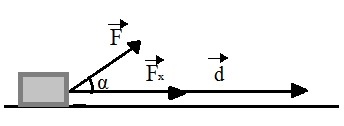In our daily lives, work is related to the exercise of some activity or service. However, in Physics, work is conceptualized differently. If there is no force and displacement, there is no work. This means that even if a person holds a heavy object for a long time, physically he is not doing work.
O mechanical work is a vector quantity that allows us to calculate the variation of energy suffered by a body or the amount of energy a body has. It can be calculated with the equation:
τ= F. d
Being:
τ - Work performed;
F – Strength;
d – displacement suffered by a body under the action of a force.
The unit of measurement of work in the International System is the Joule, named after James Prescott Joule, and is represented by the letter J. Joule can be defined as follows:
“One Joule is the amount of work done by a constant force of 1 Newton over a distance of one meter and in the same direction as that displacement.”
1J = 1N.m
Work of a constant force
Look at the figure below:

The figure shows a block being pulled by a force that makes an angle α with the horizontal
In the figure, we can see that a force is exerted F about a block. This force makes an angle α with the direction of displacement. FX is the component of force in the direction of displacement d.
To find a mathematical expression for the work done on the block, we must consider that Fx it is the only force that influences displacement. Thus, the work will be given by the expression:
τ= Fx.. d
Fx is defined by the equation:
Fx = F. cos α
we can replace Fx by F. cos α in the previous expression to obtain the work in terms of F:
τ = F.d. cos α
Types of mechanical work
The work can assume positive and negative values depending on the value of the angle α. According to the assumed value, it can be classified in three ways:
Motor work: when 0º ≤ α < 90º. The work is positive, since cos α > 0, and force and displacement have the same direction
Zero work: if α = 90º, since cos 90º = 0 and there is no displacement;
Resistant work: when 90 < α ≤ 180º. The work is negative, since cos α will assume negative values. Displacement and force have opposite meanings.
By Mariane Mendes
Graduated in Physics
Source: Brazil School - https://brasilescola.uol.com.br/o-que-e/fisica/o-que-e-trabalho-mecanico.htm



